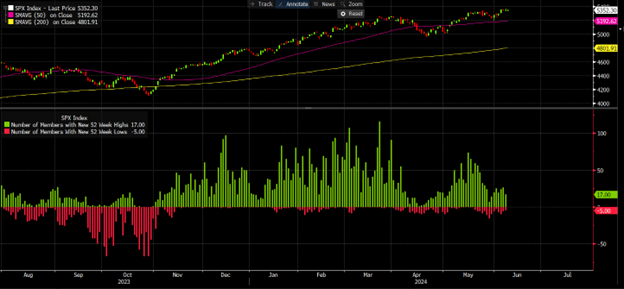Waiting for Volatility — Week of June 10, 2024

| index | wtd | ytd | 1-year | 3-year | 5-year | index level |
|---|---|---|---|---|---|---|
| S&P 500 Index | 1.36 | 12.81 | 26.40 | 9.83 | 15.07 | 5,346.99 |
| Dow Jones Industrial Average | 0.33 | 3.86 | 17.01 | 6.03 | 10.64 | 38,798.99 |
| Russell 2000 Small Cap | -2.07 | 0.55 | 9.36 | -3.42 | 7.41 | 2,026.55 |
| NASDAQ Composite | 2.40 | 14.51 | 30.47 | 8.04 | 18.22 | 17,133.13 |
| MSCI Europe, Australasia & Far East | 1.34 | 8.93 | 17.01 | 3.66 | 8.27 | 2,386.13 |
| MSCI Emerging Markets | 2.35 | 5.93 | 11.19 | -5.22 | 4.16 | 1,073.26 |
| Barclays U.S. Aggregate Bond Index | 1.27 | -0.40 | 2.82 | -2.77 | 0.01 | 2,153.40 |
| Merrill Lynch Intermediate Municipal | 1.16 | -0.94 | 2.84 | -0.81 | 1.07 | 311.93 |
As of market close June 7, 2024. Returns in percent.
Investment Insights
— Steve Orr
And we wait.
Another week, another all-time high for the S&P 500 and NASDAQ. Volatility remains stuck at August vacation levels. Can it get more boring? Well, markets can, but we bet they turn exciting this week. Let’s go global for starters. Elections in India cranked up the volatility in that market last week after Modi’s party suffered setbacks. Over the weekend, several European countries saw their ruling parties lose seats in their parliament and EU delegations. Most of the seats lost were for parties that lean left and spend freely. The uncertainty of snap elections in France and the rise of center-right parties on the continent gave traders an excuse to sell Monday morning.
The largest election effect this month was in Mexico. The controlling socialist party was expected to win, but not by a landslide. The big win gave the Morena party a super-majority in the lower house and a majority in the Senate. Currency and stock traders did not like the possibility of increased regulation and control by the party. Mexico’s BOLSA index suffered its second-worst performance week since the 2009 financial crisis, falling nearly 12%.
More fun
This Wednesday, the FOMC’s every-six-week meeting concludes with a press release and Chaiman Powell’s press conference. We expect that the Fed will leave short rates unchanged and lower their median projection for rate cuts from three to two. That morning, we and the Fed will learn that May’s consumer price index likely held steady at 3.4%.
Breadth, ticks, new highs, new lows.
Recent volatility readings have been so low that even Roaring Kitty and another good jobs headline could not roust gains out of traders. We are wary of new all-time highs in the NASDAQ and S&P 500 when only a few stocks are driving the indices higher. We would like to see the number of new stocks outpacing new lows each day. Index members making new highs or lows are part of breadth analysis, or trying to understand just how broad a rally or decline is across a market.
In the chart below, the S&P 500’s run from last October’s low saw the index post yearly new highs in the 30 to 50 range per day (green vertical bars). New 52-week lows, in contrast, were less than 10 per day. In the recent consolidation period, new highs are less than 20 per day and new lows are averaging around seven. Yes, highs are ahead of lows, but not at impressive Bull levels.

The global All-Country World and all the U.S. indices remain in uptrends. All have 50-day moving averages above their 200-day moving averages. All have prices above or near their 50-day moving average. So, the Bull trend remains in force. We may hold our nose at some of the market’s internals, but history says most of the time, problematic breadth usually resolves itself in favor of the Bulls.
Jobs, sort of
May’s non-farm payroll’s report of 272,000 net-new jobs made nice headlines. Digging into the numbers, the small business birth/death model made up 231,000 of those jobs. Further digging lead us to estimate probably 130,000 or so are “real” new jobs. Most of the gains were concentrated in what we call “government-related” fields: government positions and healthcare. Two notes: May is usually an outlier as teachers and students go for summer jobs. The net gain in the payrolls report is almost all foreign-born.
Over in the Household report, employment fell by 408,000 month over month. Net job growth year over year was less than one-quarter of a percent. The unemployment rate ticked up to 4%. The payroll report suggests that the economy can trundle along in second gear. The Household report suggests a slower path, downshifting to first gear in the coming months. We tend to go with the latter: a possible downshift to first gear.
Another indicator that the economy is doing fine is Average Hourly Earnings. This series is released with the jobs report each month and tracks wages across the U.S. The year-over-year growth in wages for May ran a healthy 4.1%. About 80% of all employment is production and non-supervisory positions. That sub-series of AHE is rising at a 4.2% clip. Both series are now running ahead of inflation and well below their 2022 peaks of 5.9% and 7%. The declining rate in wage growth is consistent with the job market coming back into balance after the shutdowns of 2020–21. This too should cheer the Fed.
Wrap-Up
Wall Street is all about sentiment and mood. For six weeks, stocks and bonds have swung back and forth between “too strong growth” and “slowing growth.” Friday’s job numbers put sentiment back on a growth footing.
A steadily growing economy does not need Fed rate cuts. It should push long-term rates slightly higher as the administration’s spending plans dump more Treasury debt onto the bond market. Slowing job growth, commodities and stocks creating trading ranges near recent highs and a second-gear economy add up to mid- or late-cycle slowdown, not recession.
Steve Orr is the Managing Director and Chief Investment Officer for Texas Capital Bank Private Wealth Advisors. Steve has earned the right to use the Chartered Financial Analyst and Chartered Market Technician designations. He holds a Bachelor of Arts in Economics from The University of Texas at Austin, a Master of Business Administration in Finance from Texas State University, and a Juris Doctor in Securities from St. Mary’s University School of Law. Follow him on Twitter here.
The contents of this article are subject to the terms and conditions available here.
Texas Capital Private Bank™ refers to the wealth management services offered by the bank and non-bank entities comprising the Texas Capital brand, including Texas Capital Bank Private Wealth Advisors (PWA). Nothing herein is intended to constitute an offer to sell or buy, or a solicitation of an offer to sell or buy securities.
Investing is subject to a high degree of investment risk, including the possible loss of the entire amount of an investment. You should carefully read and review all information provided by PWA, including PWA’s Form ADV, Part 2A brochure and all supplements thereto, before making an investment.
Neither PWA, the Bank nor any of their respective employees provides tax or legal advice. Nothing contained on this website (including any attachments) is intended as tax or legal advice for any recipient, nor should it be relied on as such. Taxpayers should seek advice based on the taxpayer’s particular circumstances from an independent tax advisor or legal counsel. The wealth strategy team at PWA can work with your attorney to facilitate the desired structure of your estate plan. The information contained on this website is not a complete summary or statement of all available data necessary for making an investment decision, and does not constitute a recommendation. The information has been obtained from sources considered to be reliable, but we do not guarantee that the foregoing material is accurate or complete. Any opinions are those of the authors and not necessarily those of PWA or the Bank.
©2025 Texas Capital Bank Wealth Management Services, Inc., a wholly owned subsidiary of Texas Capital Bank. All rights reserved.
Texas Capital Bank Private Wealth Advisors and the Texas Capital Bank Private Wealth Advisors logo are trademarks of Texas Capital Bancshares, Inc., and Texas Capital Bank.
www.texascapitalbank.com Member FDIC NASDAQ®: TCBI